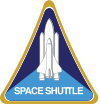STS-71
| Missionsemblem | |||||
|---|---|---|---|---|---|
 | |||||
| Missionsstatistik | |||||
| Missionsnavn: | STS-71 | ||||
| Rumagentur: | NASA | ||||
| Rumfærge: | Atlantis (14) | ||||
| Antal besætningsmedlemmer: | 7 ud, 8 hjem | ||||
| Affyringsrampe: | LC-39A (KSC) | ||||
| Opsendelse: | 27 juni 1995 | ||||
| Landing: | 7 juli 1995 | ||||
| Landet på: | KSC | ||||
| Varighed: | 9 dage 19 timer | ||||
| Foto af besætningen | |||||
 | |||||
| Navigation | |||||
| |||||
STS-71 (Space Transportation System-71) var Atlantis 14. rumfærge-mission. Opsendt 27. juni 1995 og vendte tilbage den 7. juli 1995. Det var den første mission hvor en NASA rumfærge lagde til ved den russiske rumstation MIR.
Missionen var rumfærgernes 1. sammenkobling med rumstationen Mir og 3. mission med russisk deltagelse, de to første var STS-60 og STS-63.
Efterfølgende fælles missioner til Mir: Sojuz TM-21, STS-74, STS-76, STS-79, STS-81, STS-84, STS-86, STS-89 og STS-91.
Besætning

 Robert L. Gibson (Kommandør)
Robert L. Gibson (Kommandør)
 Charles J. Precourt (Pilot)
Charles J. Precourt (Pilot)
 Ellen S. Baker (Specialist)
Ellen S. Baker (Specialist)
 Bonnie J. Dunbar (Specialist)
Bonnie J. Dunbar (Specialist)
 Gregory J. Harbaugh (Specialist)
Gregory J. Harbaugh (Specialist)
Fra jorden til MIR, besætning Mir-19
Fra MIR retur til jorden, besætning Mir-18
Missions højdepunkter
 Tekst mangler, hjælp os med at skrive teksten
Tekst mangler, hjælp os med at skrive teksten
Eksterne henvisninger
- STS-71 NASA (engelsk)
| ||||||||||||||||||||
| ||||||||
Medier brugt på denne side
The crew assigned to the STS-71 mission included (front left to right) Vladimir N. Dezhurov, Mir 18 crew download; Robert L. Gibson, commander; and Anatoly Y. Solovyev, Mir 19 crew upload. On the back row, left to right, are Norman E. Thagard, Mir 18 crew download; Gennadiy Strekalov, Mir 18 crew download; Gregory J. Harbaugh, mission specialist; Ellen S. Baker, mission specialist; Charles J. Precourt, pilot; Bonnie J. Dunbar, mission specialist; and Nikolai Budarin, Mir 19 crew upload. Launched aboard the Space Shuttle Atlantis on June 27, 1995 at 3:32:19.044 pm (EDT), the STS-71 mission marked many firsts in human space flight history. It was the first U.S. Space Shuttle-Russian Space Station Mir docking and joint on-orbit operations, and the first on-orbit change out of a shuttle crew. In addition, it was the largest spacecraft ever in orbit and was the 100th U.S. human space launch conducted from the Cape.
Forfatter/Opretter: By Rei-artur (diskussion · bidrag)., Licens: CC-BY-SA-3.0
Venus/female symbol.
SVG version of PNG Space Shuttle Logo/Patch.
STS-70 Mission Insignia
The STS-70 crew patch depicts the Space Shuttle Discovery orbiting Earth in the vast blackness of space. The primary mission of deploying a NASA Tracking and Data Relay Satellite (TDRS) is depicted by three gold stars. They represent the triad composed of spacecraft transmitting data to Earth through the TDRS system. The stylized red, white, and blue ribbon represents the American goal of linking space exploration to the advancement of all humankind.
Space Shuttle Atlantis takes flight on its STS-27 mission on December 2, 1988, 9:30 a.m. EST, utilizing 375,000 pounds thrust produced by its three main engines. The STS-27 was the third classified mission dedicated to the Department of Defense (DoD). After completion of mission, Orbiter Atlantis landed December 6, 1988, 3:36 p.m. PST at Edwards Air Force Base, California.
STS-67 Mission Insignia
Forfatter/Opretter: Rei-artur (diskussion · bidrag), reshaped by F l a n k e r (talk), Licens: CC-BY-SA-3.0
symbol of Mars. 400 × 400 pixels nominal dimensions, line 45 pixel tick, circle 295 × 295 pixel, not joined with arrow. Colour: red=0 green=0 blue=140.
![]() Vektorgrafikken blev lavet med Inkscape.
Vektorgrafikken blev lavet med Inkscape.
STS-71 Mission Insignia
The STS-71 crew patch design depicts the orbiter Atlantis in the process of the first international docking mission of the Space Shuttle Atlantis with the Russian Space Station Mir. The names of the 10 astronauts and cosmonauts who flew aboard the orbiter are shown along the outer border of the patch. The rising sun symbolizes the dawn of a new era of cooperation between the two countries. The vehicles Atlantis and Mir are shown in separate circles converging at the center of the emblem symbolizing the merger of the space programs of the two space faring nations. The flags of the United States and Russia emphasize the equal partnership of the mission. The joint program symbol at the lower center of the patch acknowledges the extensive contributions made by the Mission Control Centers (MCC) of both countries. The crew insignia was designed by aviation and space artist, Bob McCall, who also designed the crew patch for the Apollo Soyuz Test Project (ASTP) in 1975, the first international space docking mission.











